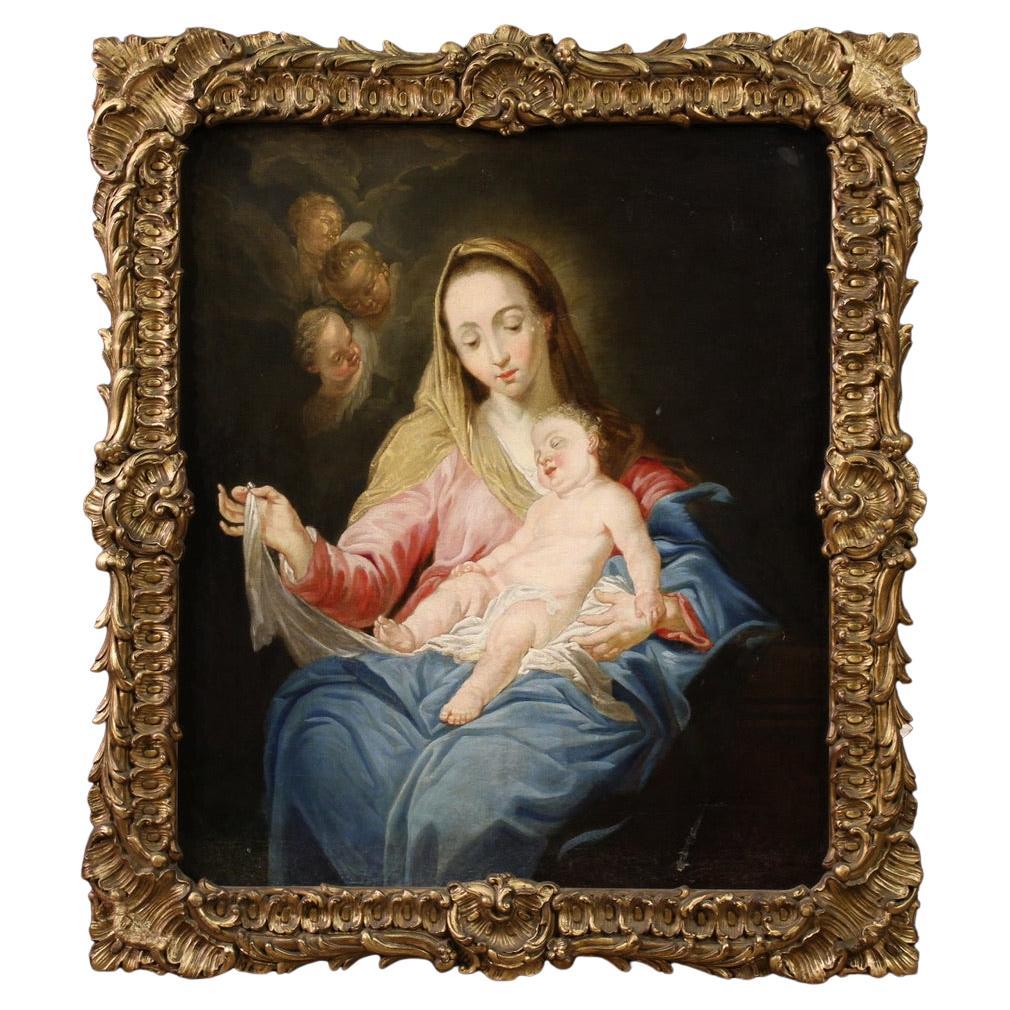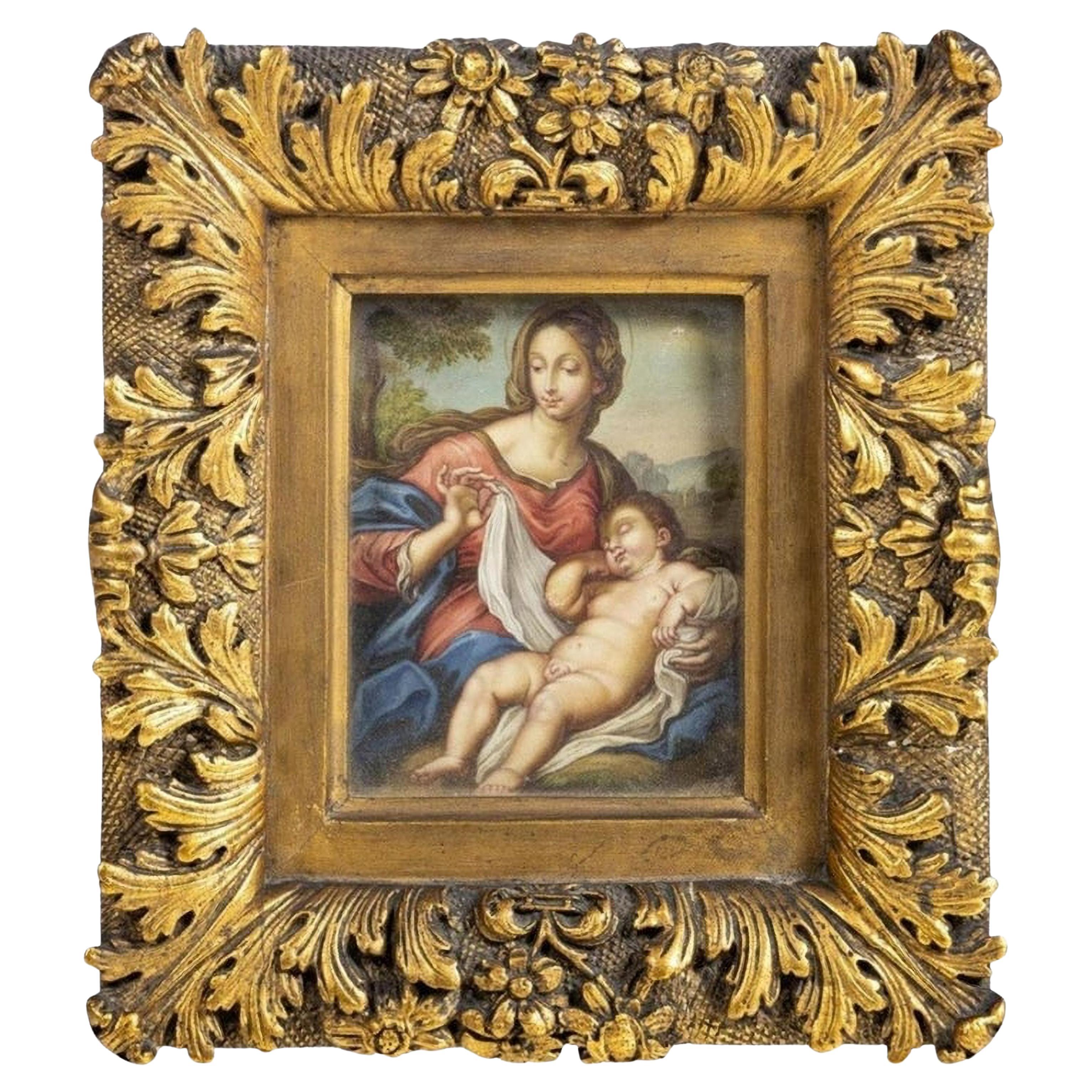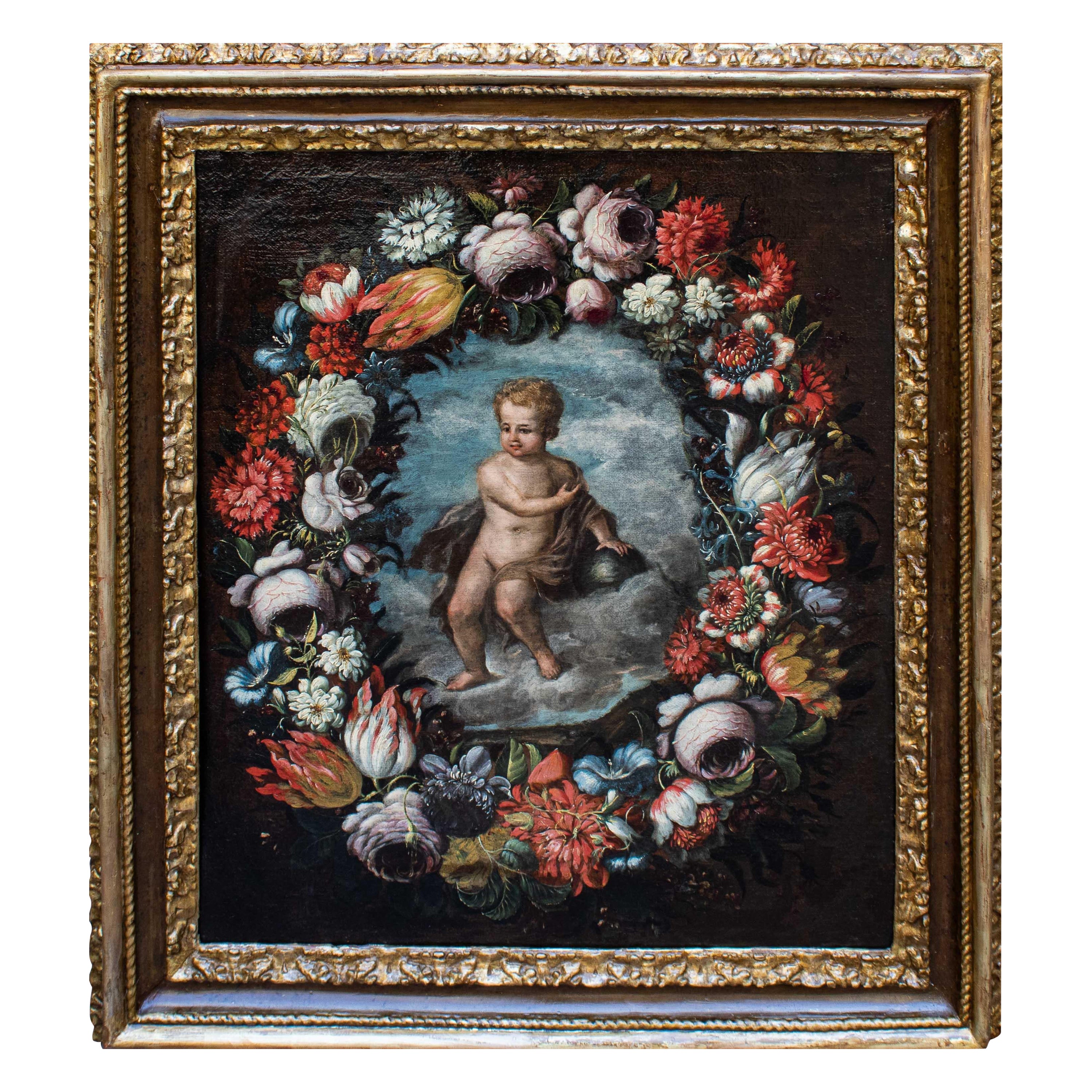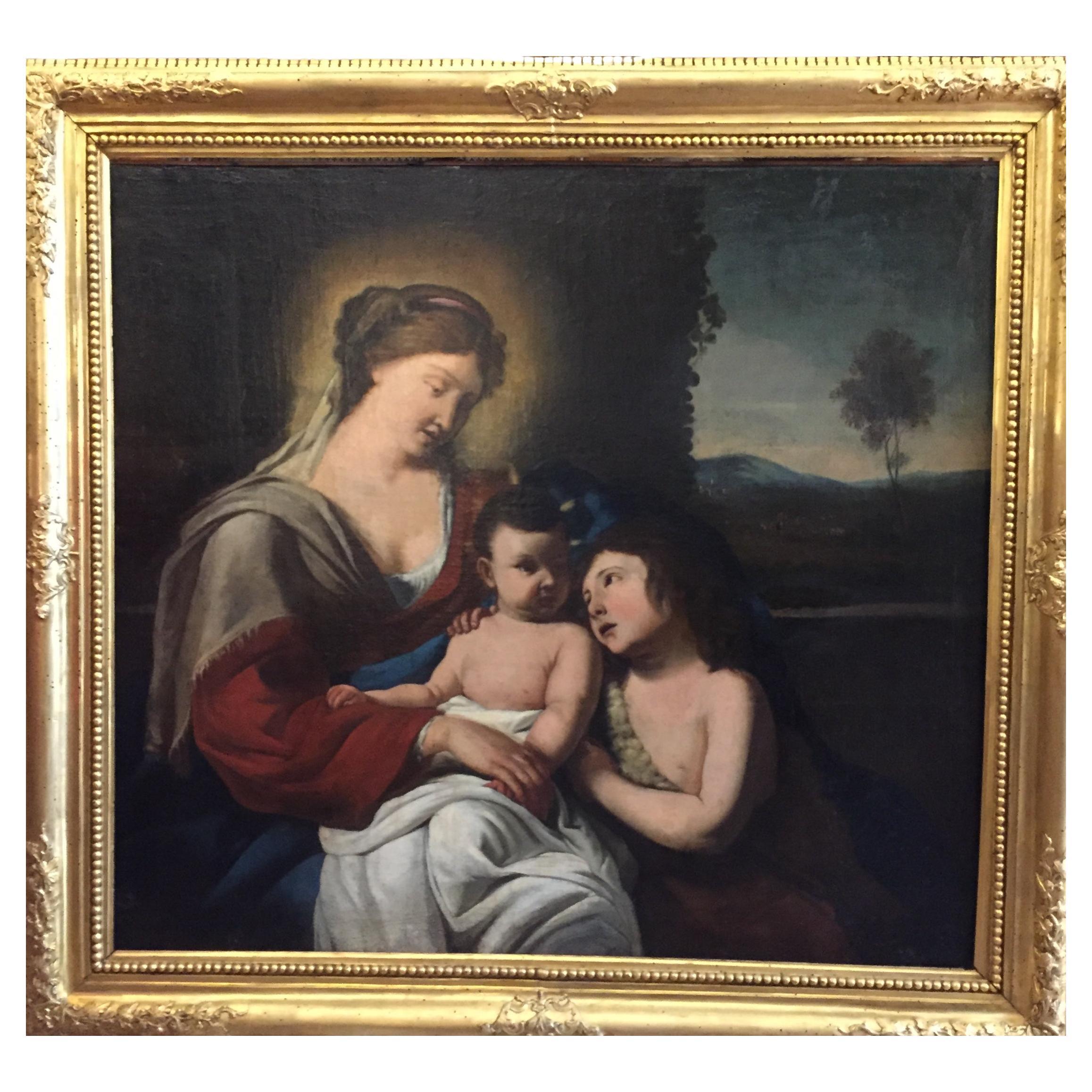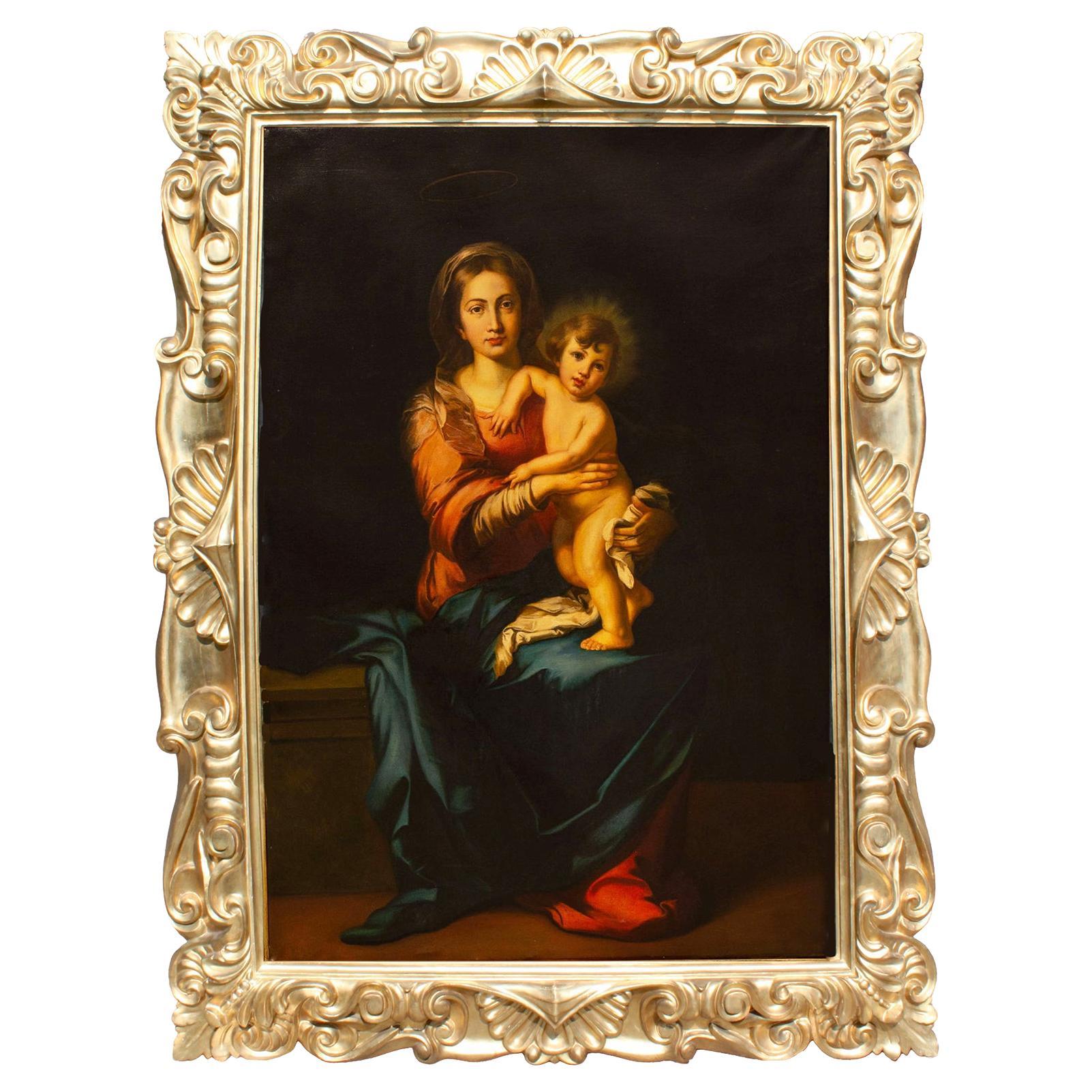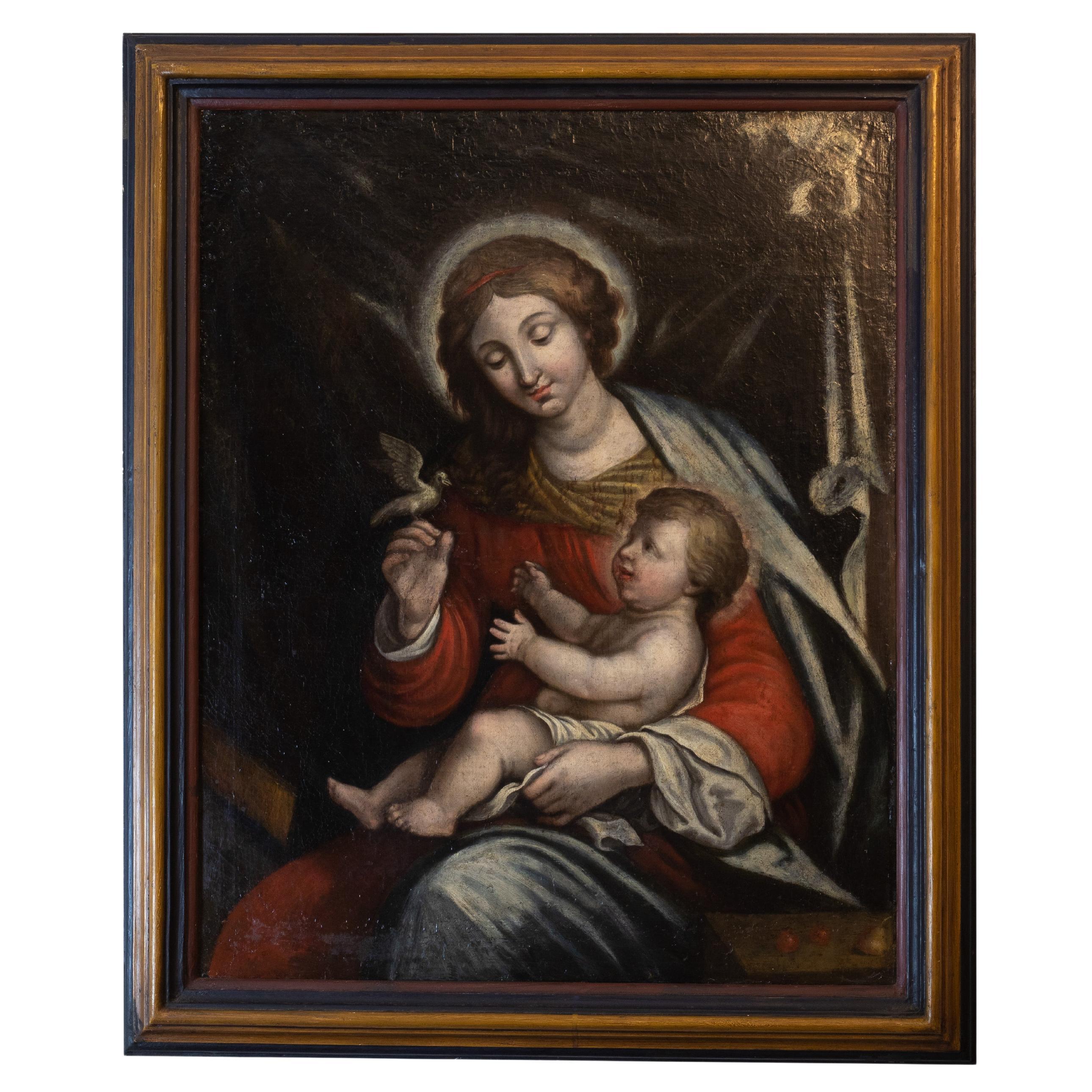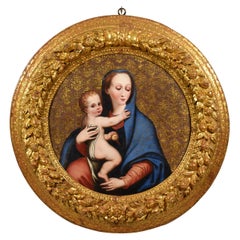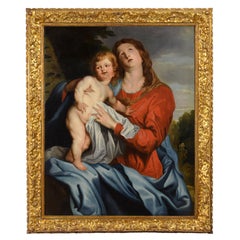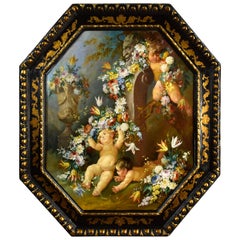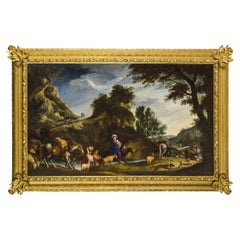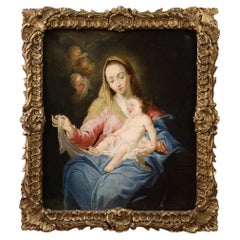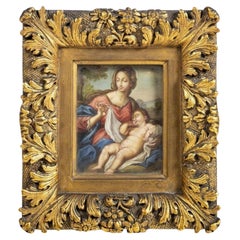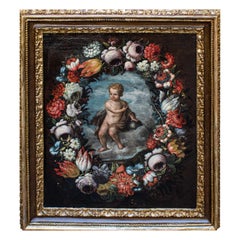Items Similar to 18th Century, Italian painting with Sacred Heart of the Child Jesus by Pietro Ba
Want more images or videos?
Request additional images or videos from the seller
1 of 19
18th Century, Italian painting with Sacred Heart of the Child Jesus by Pietro Ba
$19,493.97
£14,611.94
€16,500
CA$26,781.40
A$29,898.91
CHF 15,666.58
MX$365,992.03
NOK 198,965.73
SEK 187,599.42
DKK 125,604.02
Shipping
Retrieving quote...The 1stDibs Promise:
Authenticity Guarantee,
Money-Back Guarantee,
24-Hour Cancellation
About the Item
Pietro Bardellino (Italy - Naples, 1732 - 1806), attr., Sacred Heart of the Child Jesus
Measurements: with frame, cm L 86 x H 99 x P 8; only the canvas, cm L 78 x H 64
The painting, made in oil on canvas, represents the Sacred Heart of the Child Jesus. Stylistically the work is attributable to Pietro Bardellino (Italy, Naples, 1732 - Naples, 1806), a pupil of Francesco De Mura and considered by critics one of the most gifted and sensitive exponents of the Rococo style in Naples.
The canvas represents the Child Jesus, surrounded by flowers in an outdoor setting, while showing the sacred heart. The canvas has a well-balanced color and a strong sweetness of the child’s traits, which with the complicit gesture of the right hand, involves the viewer in the intimate and delicate sharing of the garden in which he sits. The roses, in addition to being a beautiful piece of still life, contribute to enrich the Christological message, being bearers of symbolic meanings. Marian attributes par excellence, are often side by side with Christ, whose thorns foreshadow the Passion. In the canvas, on the top left, two cherubim are observed: among them, according to the Old Testament, is God: the author therefore puts into place an iconographic and iconological hyperbole that amplifies its meaning. The iconographic theme of the Child Jesus with the Sacred Heart in his hand spread between the second half of the eighteenth century and the first of the following century. With the worship of the Sacred Heart of Jesus, the Catholic Church intends to honour the Heart of Jesus Christ, one of the organs symbolizing his humanity, which by intimate union with the Divinity, has the right to worship and love of the Saviour for men, of which His Heart is the symbol. It represents one of the fundamental devotions of Christian life, as it manifests the true face of God, who is prodigal and boundless love. It was the French mystic Saint Margaret Mary Alacoque (Verosvres, July 22, 1647 - Paray-le-Monial, October 17, 1690) the messenger of worship, which in 1856 Pope Pius IX extended to the whole Catholic Church. The subject depicted here therefore respects an established traditional iconography. Below are some known examples of such representations, which we see being spread throughout the Italian territory although in a number of works quite small enough to consider this image rare and sporadic.
Stylistically the work is attributable to one of the best students of Francesco de Mura: Pietro Bardellino. The painter was born in Naples in 1731; there is little information about his artistic training and his activity before 1756, the year in which he decorated the ceiling of the pharmacy of the Incurables. With his later works he fits into the pictorial tradition of the followers of Solimena, while showing that he knows the manner of Giacomo del Po, derived from Luca Giordano. In 1773 he became a member of the Academy of Fine Arts, called by Luigi Vanvitelli and in 1779 was appointed master of the Royal Academy of Drawing and Painting. A staunch follower of traditional painting, he remained indifferent to the stimuli of neoclassicism, which penetrated the Neapolitan environment in various ways, preferring to express themselves through an imaginative manner, rich in bright colors and luminosity effects. In the old apartment of the Royal Palace of Caserta, seven of his paintings, made in mature age and representing Science and the Arts, Peace and War, Innocence, Simplicity, Truth, Day, Night, are testimony to harmony, of pictorial airiness and of the vigorous chromatic palette, characterized by lively chiaroscuro, which are its own. Attentive to the trends of North European art of great fashion at the court of Maria Carolina of Saxony, wife of Ferdinand IV, the painter lightens the compositions of his master, explaining an elegant Rococo taste in a southern key. In 1803 he was entrusted, together with Desiderio De Angelis, with the nude school at the Academy, then directed by G. B. Wicar; the post was confirmed by the Napoleonic government in 1806, the year of his death.
The canvas object of this study presents a stylistic setting and a chromatic palette very close to many works by Bardellino with games of putti per subject. Similar characteristics can be observed, such as the combination of pink with intense blue, the deep looks of the subjects depicted and the softness of the trait with which the painter describes the plump bodies of Bambinelli and putti.
We apologize for any errors in translation from Italian.
- Attributed to:Pietro Bardellino (Artist)
- Dimensions:Height: 38.98 in (99 cm)Width: 33.86 in (86 cm)Depth: 3.15 in (8 cm)
- Style:Baroque (Of the Period)
- Materials and Techniques:
- Place of Origin:
- Period:
- Date of Manufacture:Mid-18th Century
- Condition:Wear consistent with age and use.
- Seller Location:IT
- Reference Number:1stDibs: LU4405225241672
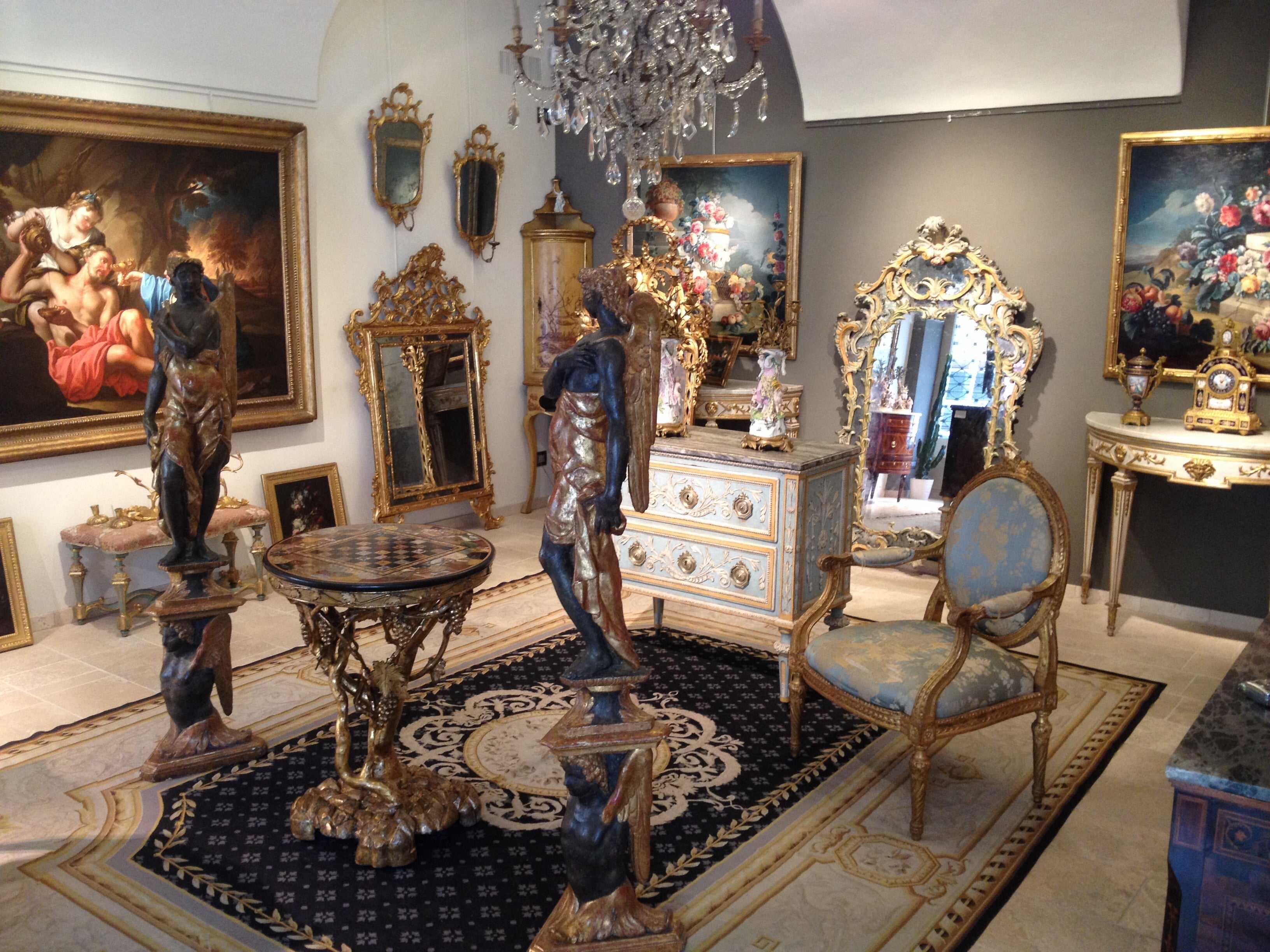
About the Seller
5.0
Platinum Seller
Premium sellers with a 4.7+ rating and 24-hour response times
Established in 1980
1stDibs seller since 2019
56 sales on 1stDibs
Typical response time: 1 hour
- ShippingRetrieving quote...Shipping from: Italy
- Return Policy
Authenticity Guarantee
In the unlikely event there’s an issue with an item’s authenticity, contact us within 1 year for a full refund. DetailsMoney-Back Guarantee
If your item is not as described, is damaged in transit, or does not arrive, contact us within 7 days for a full refund. Details24-Hour Cancellation
You have a 24-hour grace period in which to reconsider your purchase, with no questions asked.Vetted Professional Sellers
Our world-class sellers must adhere to strict standards for service and quality, maintaining the integrity of our listings.Price-Match Guarantee
If you find that a seller listed the same item for a lower price elsewhere, we’ll match it.Trusted Global Delivery
Our best-in-class carrier network provides specialized shipping options worldwide, including custom delivery.More From This Seller
View All17th Century, Italian Oil on Panel Painting Depicting Madonna della Purità
Located in IT
17th Century, Italian Oil on Panel Painting Depicting Madonna della Purità
The painting, executed in oil on a circular wooden panel and presented in an imposing carved and gilded wo...
Category
Antique 17th Century Italian Renaissance Paintings
Materials
Wood, Giltwood
17th Century, Italian Painting with Virgin and Child by Follower of Van Dyck
By Anthony van Dyck
Located in IT
17th century, Italian painting with virgin and childr by Follower of Sir Anthony van Dyck
cm W 90 x H 113; cornice cm W 111 x H 135 x D 7
The canvas depicts the Madonna with the Chi...
Category
Antique Late 17th Century Italian Baroque Paintings
Materials
Canvas
19th Century, Italian Painting with Still Life with Cherubs
Located in IT
19th century Roman painter
Still life with cherubs, flower festoons and herma with faun
Measures: Oil on canvas, cm H 78 x W 95 without frame
Cm H 122.00 x W 106 x D 8 with frame.
The work, painted in oil on canvas, octagonal in shape, represents a nature with three putti or cupids playing with flower festoons in a wooded environment in which is placed a herma with faun and, on the left, a large neoclassical marble vase...
Category
Antique 19th Century Italian Baroque Paintings
Materials
Canvas
17th Century, Italian Painting by Pier Francesco Cittadini, Jacob and his Family
Located in IT
Pier Francesco Cittadini (Milan, 1616-Bologna, 1681)
"Jacob and his family go to Egypt"
Oil on canvas, cm 109 x 190 (canvas only)
The valuable painting, made in oil on canvas, depicts Jacob and his family go to Egypt and we believe it can be, given the high quality painting, autograph work of Italian Pier Francesco Cittadini (Italy Milan, 1616 - Bologna, 1681) made after 1647. The work, in excellent condition is accompanied by a coeval frame in wood finely carved and golden.
The scene depicted, which was confused with the Flight to Egypt in the past years, is instead identified with the biblical episode of Jacob’s journey. In the foreground, reading the painting from left to right, we see a caravan composed of animals, including donkeys, dromedaries, goats, dogs and horses and people, women, men and slaves, who carry on their journey along the banks of a river, following a path that to the right, would seem to lead to the through of a bridge. In addition to the watercourse is described an environment characterized by large rocks and impervious come far to cover the entire verticality of the canvas. On the left, in the distance, we see the tail of the caravan that runs along the steep path. Large trees enliven and harmonize the environment, as well as white and grey clouds characterize the predominantly clear sky and illuminated on the right by sunlight.
The story is told in the Bible, Book of Genesis, 30, 25, passage in which is described the flight of Jacob from Haran after the contrasts with Laban, father of his wife Rachel. Jacob is the third great patriarch of the Bible. From his descendants originate the twelve generations of the people of Israel. He is the son of Isaac and Rebekah, who led him to flee from the wrath of Esau to Haran to seek refuge from his brother, Laban. At his uncle’s house Jacob met his daughter Rachel. As soon as he saw his cousin, Jacob was taken. Jacob will stay seven years in the service of Laban to marry his beloved Rachel. But Laban, with a deception, will give him in marriage first Lia, the least beautiful eldest daughter, and only after another seven years the splendid Rachel. From his first wife he will have several children, while Rachel will give birth to the beloved son, Joseph, who will become viceroy of Egypt.
After years of service, Jacob asked to be paid with every dark-coloured garment among the sheep and every spotted and dotted garment among the goats. Laban accepted and sent away from his sons all the leaders of that kind. So Jacob took fresh branches of poplar, almond and plane tree, and flayed them, and put them in the troughs. The optical suggestion induced the goats and the sheep to conceive and give birth to dark, striped and dotted garments. He also ensured that all the strongest and healthiest leaders of the flock of Laban would drink near the barked branches, thus assuring a genetic superiority to his part of the flock. His flocks grew numerous and strong and he became richer than his relative, arousing envy. It was clear that Laban would not respect him much longer. At the suggestion of the Lord, Jacob decided to return to Canaan. Trying to avoid any possible dispute, he left with his family while Laban was absent for shearing sheep. But when, three days later, his uncle returned home, he became angry, feeling offended because Jacob had gone secretly and had not allowed him to greet his daughters and grandchildren. In addition, his teraphim, statuettes, or idols, which depicted the family deities, had disappeared. After 7 days of pursuit, Laban and his men reached Jacob’s group on Mount Gilead, in the mountainous region west of the Euphrates River, where his uncle and grandson had a stormy conversation. The younger man was outraged at being accused of stealing idols and told Labano to rummage through his family’s tents at will. Neither of them could know or even imagine that it was Rachel who took the idols and hid them in the saddle of the camel. During the search, she sat down firmly on the saddle, apologizing for not being able to get up, «because I usually have what happens to women» (Gen 31:35). So the loot wasn’t discovered.
The author of this work was inspired by the composition of an engraving by Stefano Della Bella (1610-1664) of circa 1647. The engraving by Stefano della Bella bears the title "Iacob sur ses vieux jours quitte sans fascherie pour voir son filz Ioseph, sa terre et sa patrie" and is signed on the bottom left "Stef. of the Beautiful In. et fe." while on the right it is declared "Cum privil. Regis", that is with license of the king.
Stefano Della Bella (Italy - Florence, May 18, 1610-Florence, July 12, 1664) was born in a family of painters, sculptors and goldsmiths and was left early orphan of his father sculptor, he dedicated himself first to the art of goldsmith at the school of Giovanni Benedetto Castiglione and Gasparo Mola, then turning his attention to drawing and engraving. He soon began drawing figures and copying the etchings of Jacques Callot, which inspired his early works. Under the protection of the Medici, in particular of Don Lorenzo, cadet son of Grand Duke Ferdinand I, Della Bella has the opportunity to make study trips to Rome, where he stayed from 1633-1636; In Rome he met French engravers and publishers of prints such as Israël Henriet and François Langlois, who influenced his decision to move to Paris in 1639, four years after the death of Callot. In Paris he soon reached, thanks to the engravings commissioned by Cardinal Richelieu, the success also worldly; he frequented courtiers, theatre artists and writers, while refusing too oppressive honors. In 1646-1647 he continued his travels in the Netherlands to Amsterdam, Antwerp and Dordrecht. He returned to Florence in 1650 and resumed working under the protection of the Medici court, working for his patrons. In 1656 he became a member of the Academy of Apatists.
The painting object of this study is reasonably attributable to Pier Francesco Cittadini, or Pierfrancesco Cittadini, called the Milanese or the Franceschino (Italy - Milan, 1616-Bologna, 1681) as some exemplary stylistic comparisons proposed to follow can prove.
Pier Francesco Cittadini was an Italian baroque painter, mainly active in Bologna.
His artistic training first took place with the painter Daniele Crespi...
Category
Antique Mid-17th Century European Baroque Paintings
Materials
Canvas, Giltwood
18th Century, Italian Still Life Painting Attributed to Francesco Lavagna
By Francesco Lavagna
Located in IT
Francesco Lavagna (Italy -Naples 1684-1724)
"Still life with flowers and watermelon and hermas with garden in the background"
The painting, beautifully made and in good condition, d...
Category
Antique Early 18th Century Italian Baroque Paintings
Materials
Canvas
$17,485 Sale Price
20% Off
18th Century, Italian Rococo Still Life Painting by Michele A. Rapos
By Michele Antonio Rapos
Located in IT
Michele Antonio Rapos (Turin 1733-1819), Still life of flowers and fruits,
Oil on canvas
frame: cm H 133 x W 124 x D 8 (canvas: cm 108.5 x 108.5)
The painting depicts a triumph of ...
Category
Antique Late 18th Century Italian Rococo Paintings
Materials
Canvas, Giltwood
$39,696 Sale Price
20% Off
You May Also Like
18th Century Oil on Canvas Italian Religious Painting Madonna with Child, 1750
Located in Vicoforte, Piedmont
Splendid Italian painting from the 18th century. Oil painting on canvas depicting a wonderful Madonna with sleeping child, of remarkable pictorial quality. For the delicacy of the co...
Category
Antique 1750s Italian Paintings
Materials
Canvas
Antonio Allegri, Our Lady with the Child Jesus 16th Century
By Antonio da Correggio
Located in Madrid, ES
Antonio Alegri, (Correggio - 1494-1534)
Our Lady with the Child Jesus
oil on copper,
Italian School 16th century
With inscription on the back '1494-1534...
Category
Antique 16th Century Italian Baroque Paintings
Materials
Copper
Oil on canvas Jesus child within garland of flowers 18th century
Located in Milan, IT
Lombard School, 17th century
Christ child with globe within garland of flowers
Oil on canvas, 72 x 61 cm
Framed 90, 5 x 80
The present painting, framed by a sumptuous antique fr...
Category
Antique 18th Century Paintings
Materials
Canvas
Madonna con Bambino e San Giovannino Dipinto Religioso Italiano 1650 circa
Located in Milano, MI
Dipinto religioso italiano di Scuola Lombarda Madonna con Bambino e San Giovannino circa 1650 con una buona composizione equilibrata ed armoniosa al centro della quale si trova il Bi...
Category
Antique Mid-17th Century Italian Baroque Paintings
Materials
Canvas, Giltwood
Large & Impressive Oil on Canvas "Madonna & Child" After Murillo - V. Bianchini
By Bartolomé Esteban Murillo
Located in Los Angeles, CA
A Large and Impressive Early 20th Century Oil on Canvas "Madonna and Child" After Bartolomé Esteban Murillo (Spanish, 1618-1682) depicting a seated Virgin Mary with a baby Jesus Chri...
Category
Vintage 1910s Italian Baroque Paintings
Materials
Canvas, Giltwood
Our Lady of Peace Italian Renaissance Religious Painting, 18th Century
Located in Lisbon, PT
An 18th-century Italian Renaissance oil painting of Our Lady of Peace, depicting Mary in red and green robes holding the Christ Child and a white dove. Against a dark, atmospheric ba...
Category
Antique 18th Century Italian Renaissance Paintings
Materials
Canvas
$23,440 Sale Price
39% Off
